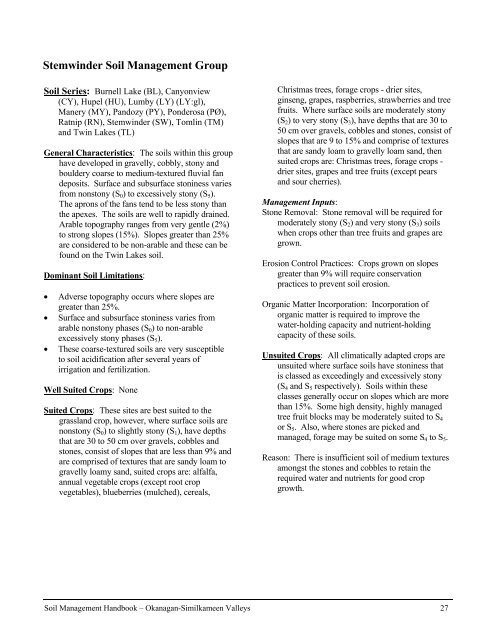Soil Management Handbook - Ministry of Agriculture and Lands
Soil Management Handbook - Ministry of Agriculture and Lands
Soil Management Handbook - Ministry of Agriculture and Lands
You also want an ePaper? Increase the reach of your titles
YUMPU automatically turns print PDFs into web optimized ePapers that Google loves.
Stemwinder <strong>Soil</strong> <strong>Management</strong> Group<br />
<strong>Soil</strong> Series: Burnell Lake (BL), Canyonview<br />
(CY), Hupel (HU), Lumby (LY) (LY:gl),<br />
Manery (MY), P<strong>and</strong>ozy (PY), Ponderosa (PØ),<br />
Ratnip (RN), Stemwinder (SW), Tomlin (TM)<br />
<strong>and</strong> Twin Lakes (TL)<br />
General Characteristics: The soils within this group<br />
have developed in gravelly, cobbly, stony <strong>and</strong><br />
bouldery coarse to medium-textured fluvial fan<br />
deposits. Surface <strong>and</strong> subsurface stoniness varies<br />
from nonstony (S0) to excessively stony (S5).<br />
The aprons <strong>of</strong> the fans tend to be less stony than<br />
the apexes. The soils are well to rapidly drained.<br />
Arable topography ranges from very gentle (2%)<br />
to strong slopes (15%). Slopes greater than 25%<br />
are considered to be non-arable <strong>and</strong> these can be<br />
found on the Twin Lakes soil.<br />
Dominant <strong>Soil</strong> Limitations:<br />
• Adverse topography occurs where slopes are<br />
greater than 25%.<br />
• Surface <strong>and</strong> subsurface stoniness varies from<br />
arable nonstony phases (S0) to non-arable<br />
excessively stony phases (S5).<br />
• These coarse-textured soils are very susceptible<br />
to soil acidification after several years <strong>of</strong><br />
irrigation <strong>and</strong> fertilization.<br />
Well Suited Crops: None<br />
Suited Crops: These sites are best suited to the<br />
grassl<strong>and</strong> crop, however, where surface soils are<br />
nonstony (S0) to slightly stony (S1), have depths<br />
that are 30 to 50 cm over gravels, cobbles <strong>and</strong><br />
stones, consist <strong>of</strong> slopes that are less than 9% <strong>and</strong><br />
are comprised <strong>of</strong> textures that are s<strong>and</strong>y loam to<br />
gravelly loamy s<strong>and</strong>, suited crops are: alfalfa,<br />
annual vegetable crops (except root crop<br />
vegetables), blueberries (mulched), cereals,<br />
Christmas trees, forage crops - drier sites,<br />
ginseng, grapes, raspberries, strawberries <strong>and</strong> tree<br />
fruits. Where surface soils are moderately stony<br />
(S2) to very stony (S3), have depths that are 30 to<br />
50 cm over gravels, cobbles <strong>and</strong> stones, consist <strong>of</strong><br />
slopes that are 9 to 15% <strong>and</strong> comprise <strong>of</strong> textures<br />
that are s<strong>and</strong>y loam to gravelly loam s<strong>and</strong>, then<br />
suited crops are: Christmas trees, forage crops -<br />
drier sites, grapes <strong>and</strong> tree fruits (except pears<br />
<strong>and</strong> sour cherries).<br />
<strong>Management</strong> Inputs:<br />
Stone Removal: Stone removal will be required for<br />
moderately stony (S2) <strong>and</strong> very stony (S3) soils<br />
when crops other than tree fruits <strong>and</strong> grapes are<br />
grown.<br />
Erosion Control Practices: Crops grown on slopes<br />
greater than 9% will require conservation<br />
practices to prevent soil erosion.<br />
Organic Matter Incorporation: Incorporation <strong>of</strong><br />
organic matter is required to improve the<br />
water-holding capacity <strong>and</strong> nutrient-holding<br />
capacity <strong>of</strong> these soils.<br />
Unsuited Crops: All climatically adapted crops are<br />
unsuited where surface soils have stoniness that<br />
is classed as exceedingly <strong>and</strong> excessively stony<br />
(S4 <strong>and</strong> S5 respectively). <strong>Soil</strong>s within these<br />
classes generally occur on slopes which are more<br />
than 15%. Some high density, highly managed<br />
tree fruit blocks may be moderately suited to S4<br />
or S5. Also, where stones are picked <strong>and</strong><br />
managed, forage may be suited on some S4 to S5.<br />
Reason: There is insufficient soil <strong>of</strong> medium textures<br />
amongst the stones <strong>and</strong> cobbles to retain the<br />
required water <strong>and</strong> nutrients for good crop<br />
growth.<br />
<strong>Soil</strong> <strong>Management</strong> <strong>H<strong>and</strong>book</strong> – Okanagan-Similkameen Valleys 27
















